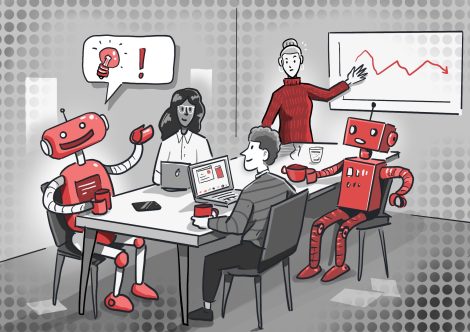The AI Revolution Is (Not) Making Our Workplaces More Human

We are currently witnessing significant advances in the world of artificial intelligence (AI). The potential impact of AI on the world of work is also the subject of intense debate in the literature. Up to 50 percent of jobs could be automated in the next decade. At the same time, positive effects on employment are predicted. What will determine which direction we take?
A new wave of AI has begun
Since US researcher John McCarthy coined the term artificial intelligence (AI) in 1956, it has inspired research. As a result, AI has gone through several waves, primarily producing what is known as “weak AI”. Examples of this type of AI are the voice assistants in our cell phones and smart home systems, which are limited to solving specific problems. However, we are currently witnessing the dawn of a new era: the emergence of “strong AI” (also known as Artificial General Intelligence, AGI), which is designed to autonomously mimic human cognition (Russell & Norvig, 2021). Although today’s popular AI tools are still considered weak rather than strong AI, the release of generative AI tools in 2022, such as DALL-E or ChatGPT, is a milestone and a kind of starting signal for strong AI.
More and more AI will be used privately and professionally (McKinsey & Company, 2023), for example by using Large Language Models (LLM) such as Google Bard or OpenAI’s ChatGPT as sparring partners, search engines or text generators. The integration of AI into the world of work triggers mechanisms similar to previous industrial revolutions. This raises the question of how the use of AI will affect our world of work.
Kolade and Owoseni (2022) examined this very question in their meta-analysis, in which they analyzed 68 sources dealing with the influence of digital transformation (including AI technologies) on the future of work. The authors emphasize that digital transformation is automating many jobs, which has led to an increase in inequality in some areas, but also has the potential to create new jobs and increase productivity.
When machines replace humans
In the past, it was mostly left to the science fiction genre to sketch out future scenarios of AI and humans living together. A central concern was and still is that humans will be replaced by AI. Similarly, some literature predicts that the integration of AI into our working world will lead to the automation of up to 50 percent of existing jobs in the next ten years, making certain areas of work obsolete. This will most likely lead to job losses and reorganization. Low-skilled workers performing highly routinized tasks could be particularly affected. The meta-analysis also shows that digitization tends to favour occupational groups that are at the core of information flows, for example in the IT sector. This could lead to a further polarization of the labour market, widening the gap between well-paid, high-skilled positions and lower-skilled, low-paid jobs (Kolade & Owoseni, 2022).
People at the center of the AI world of work
The future need not be bleak. According to the World Economic Forum’s annual Future of Jobs 2023 survey, 85% of companies already recognize the transformative power of new technologies, led by AI, and their impact on different occupations. Remarkably, the majority of companies surveyed worldwide expect the impact on employment to be positive, with the adoption of advanced technologies such as AI expected to create more jobs than it eliminates. Not surprisingly, 75 percent of the companies surveyed believe it is likely or very likely that they will integrate AI in the next five years.
Another benefit of delegating repetitive tasks to AI is that it frees up space for more creative and intellectually challenging activities. The ability to focus on higher-value tasks could lead to an increase in employee satisfaction and productivity. It could also lead to an increase in the demand for qualified labor: As the use of AI increases, more qualified workers will be needed to understand, implement, and maintain these technologies. This could help promote a knowledge society and emphasize the importance of lifelong learning (Kolade & Owoseni, 2022).
Industry 5.0 means Employment 5.0: the direction is in our hands
It is becoming clear that we are on the cusp of a new industrial revolution. Leaders are called upon to actively shape the future of work (WEF, 2023). In line with this, Kolade and Owoseni (2022) argue for thoughtful consideration of the values that should underpin it: Humanity, Sustainability, and Resilience. These should be enabled by a focus on decentralized and flexible work, lifelong learning, and the targeted deployment of skilled workers. It is up to us to steer Industry 5.0 in a direction that prioritizes these values and ensures that humans and AI can coexist and collaborate profitably.
The values of humanity, resilience and a commitment to sustainability are an integral part of HRpepper’s DNA. Our Human Business Design Framework, used in transformation projects, places people at the center of positive change in organizations. It requires future-oriented approaches to integrate these values into the backbone of digital transformations, such as the adoption of AI.
Is the AI transformation also a concern for you? You can find more information about our transformation portfolio here.
Sources:

